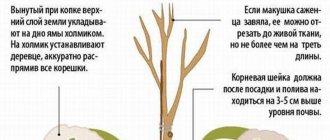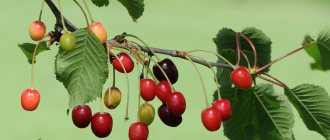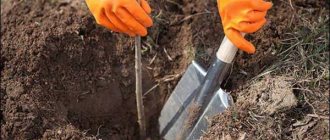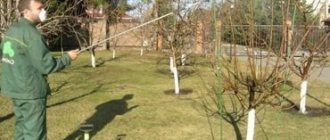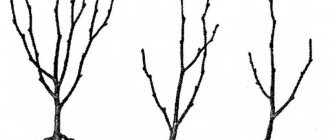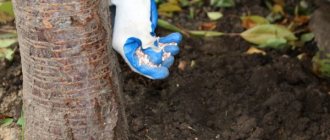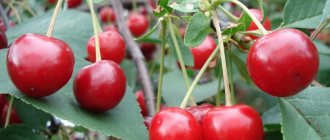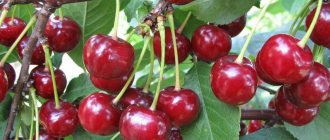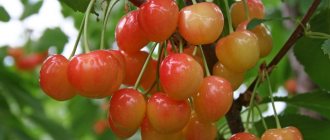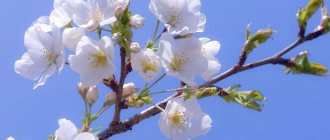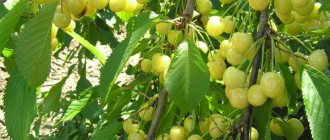If you cannot boast of a large plot, then when choosing a cherry variety for yourself, you should focus not only on its characteristics (yield, fruit weight, taste, resistance to pests and diseases), but also on its self-fertility.
Self-fertility is the ability of trees to produce fruit without cross-pollination with trees of other varieties. Those gardeners who own small plots and do not have the opportunity to place several varieties blooming at the same time for mutual cross-pollination will have to select self-fertile varieties of cherries. Unfortunately, not many varieties are capable of self-pollination.
We have selected the top 7 best self-fertile cherry varieties and placed them in descending order of self-fertility (from the highest to the minimum value of this indicator). All these varieties will definitely please you with a decent harvest, even far from the “sister” trees.
It is important to understand that the yield of mutually pollinated cherry trees will always be higher than that of self-pollinated plants. This is a specific feature of the crop - to obtain the maximum yield stated in the description of the variety, cherries need pollinating varieties.
Homestead yellow
This variety is the leader of our top, as it has the highest self-fertility among the known cherry varieties. Due to the fact that the tree is of medium size, and the fruits are tasty and aromatic, the Garden Yellow is always a welcome guest in any garden plot, even a small one.
The yellow color of the fruits will add charm and charm to the garden, decorate the table and diversify the gardener's diet. You don’t have to wait long for fruits - the trees quickly begin to bear fruit, are characterized by active growth and high resistance to both diseases and pests, and to winter frosts, and even spring frosts.
Cherries of this variety will always provide you with a harvest, because its fruits hang on the branches without falling off or cracking even in rainy weather.
| Entry into fruiting | Tree height (m) | Fruit weight (g) | Harvest | Pollinator varieties |
| For the 5th-6th year | 3,5-4,5 | 5,0-5,5 | Early July | Does not require pollinating varieties |
Bereket
This variety is highly self-fertile, but to increase the yield, one or a couple of varieties of pollinators can be added to it. The variety was obtained at the very beginning of the 21st century, and therefore is characterized by all the characteristics inherent in modern varieties - high winter hardiness and drought resistance, as well as resistance to pests and diseases.
Trees of the Bereket variety are medium in size; they are suitable for any, even the most modest plot. The plants quickly begin to bear fruit and produce beautiful dark red fruits with juicy, surprisingly tasty pulp.
The undoubted advantages of the variety include the high transportability of the fruits and the absence of the need for formative pruning of the tree, which makes it simply ideal for planting in the country.
| Entry into fruiting | Tree height (m) | Fruit weight (g) | Harvest | Pollinator varieties |
| For the 4th-5th year | 4,8-5,3 | 5,6-6,3 | Beginning – mid-June | Self-fertile, but when pollinated by Iput and Revna varieties, the yield increases |
Red-fruited varieties
When choosing which cherries to plant, most people prefer red-fruited varieties - their taste lacks the slight bitterness felt in yellow berries. The best for the Moscow region are:
| Name | Term | Weight (g) | Pollinators | Height (m) | Productivity (c/ha) |
| Bull's heart | Average | To 10 | Veda, Leningradskaya red or pink, Michurinka, Revna, Tyutchevka | 4 | Up to 150 |
| Leningradskaya black | Average | Up to 5 | Veda, Leningradskaya red or pink, Michurinka, Revna, Tyutchevka | 3-4 | 73 |
| Ovstuzhenka | Early | 4.2 | Bryansk pink, Raditsa, Revna, Tyutchevka | Up to 4 | 102 |
| Raditsa | Early | 4.6 | Iput, Revna, Tyutchevka | 3-4 | 60 |
Goryanka
The variety was bred in the last century, but this does not mean that it is obsolete. It will give a head start to any, even the most modern cultivar, because its trees have moderate growth, resistance to drought and frost, as well as diseases and pests.
The fruits of this variety quickly set after flowering and ripen together, turning into elegant dark burgundy “dresses” with pleasant, juicy and very tasty pulp.
The variety is remarkable in that it produces good yields even if only a single tree is planted on the site. The fruits can be transported over long distances without damage, and the seeds in the berries are small and are very easily separated from the pulp.
The variety is suitable for growing in dachas and small farms.
| Entry into fruiting | Tree height (m) | Fruit weight (g) | Harvest | Pollinator varieties |
| For the 4th-5th year | 4,1-4,7 | 6,0-6,4 | Beginning – mid-June | Self-fertile, but when pollinated by Iput and Revna varieties, the yield increases |
Selection of seedlings
Cherry seedlings 1-2 years
The choice of cherry seedlings must be approached seriously, because... Further successful fruit growing depends on this. Seedlings should not be mature trees that are 3 or more years old.
The best option is 1-2 year old plants, with 3-4 frame branches and a length of up to 0.5 m, with a trunk diameter of 16 mm. If the trees are older, adaptation takes longer and the seedlings tolerate new natural and soil conditions less well. When choosing, you should pay attention to the roots and trunk.
The roots are well developed without damage. The trunk is smooth, has a smooth surface, and is free of spots, scales and wrinkles. There should be no broken buds on the seedling, because... Only from them do young shoots appear.
Cherry planting scheme
Cherries are planted in spring or autumn. In spring, you need to catch the short period between the cold nights and the beginning of bud break. In the middle zone, this is the third ten days of April.
But in the fall the planting period is quite long - from the beginning of September to the end of October. During the autumn planting period, you need to be guided by the fact that the seedling must have time to take root before frost sets in.
Cherry is a southern guest in mid-latitudes, so when choosing a planting site, you should adhere to some features:
- there must be an obstacle from the north. Protect young seedlings from cold northern winds. To do this, you can either use the buildings protecting the northern side of the cherry tree, or plant it behind garden trees;
- sunny side. Cherry is a sun-loving plant, so if you choose a shaded place to plant it, you may not expect good harvests;
- elevation. Beware of lowlands when choosing a landing site, because... High humidity can lead to fungal diseases and rotting of the root system. For planting, choose hills so that the place is well-ventilated, but not from the north.
After choosing a location, begin preparing the hole. Its diameter should be 1 m and its depth 0.7 m. Mixed mineral and organic fertilizers should be placed at the bottom of the pit and given the shape of a hill. But add fertilizer to the seedling, drive a stake and tie the plant. Fill the hole with fertile soil and create a groove. Be sure to water the seedling well.
Tyutchevka
A modern variety of sweet cherry with a whole range of useful and necessary traits for any summer resident - this is sufficient self-fertility, and modest size of the tree, and resistance to diseases, pests, frost and drought, as well as early entry into the fruiting season and, of course, excellent taste and color fruits that are good both in compote and fresh when they are full of sweet juice.
The fruits have a bizarre, wide-rounded shape, a pleasant dark red “outfit” and surprisingly juicy, tasty red pulp.
It is recommended to plant this variety on your own plot because its fruits are very pleasant to collect. The thing is that their stalk is thick and quite long, and the berries themselves come off easily, almost effortlessly, and the ripe ones hang on the branches without falling, as if waiting for you.
Due to the fact that the fruits are well transported, you can easily transport them from your dacha to your home.
| Entry into fruiting | Tree height (m) | Fruit weight (g) | Harvest | Pollinator varieties |
| For the 4th-5th year | 4,0-4,3 | 5,3-7,4 | End of June – beginning of July | Self-fertile, but when pollinated by Ovstuzhenka or Raditsa varieties, the yield increases |
Biological characteristics of the cherry fruit tree
Cherries belong to the Rose family.
There are more than 4 thousand different varieties in the world, but they all originate from the “bird cherry”. Wild cherries grow in warm regions, forming dense thickets on slopes. There the tree can grow 10 meters in height, spreading its branches widely. Cultivated varieties are limited to 4 meters. By pruning and forming seedlings, they are given a tiered, fan or bush shape. A two-year-old seedling is planted, which must be grafted. The soil for a young plant needs light, fertilized and neutral reaction. The tree is placed on a southern or eastern slope, with good protection from the winds. Groundwater should be very deep, and surface watering should be regular, preferably drip. The best varieties of cherries zoned for the Moscow region can be purchased at the Moscow Nursery of Nature Testers.
The methods of radiation and chemical mutagenesis accelerated the production of new varieties. Breeder Evstratov exposed the planting material to gamma irradiation and used biological stimulants. As a result, some of the new varieties in state tests withstood temperatures down to -30 degrees and acquired early fruiting and resistance to hole spot. Active growth in summer quickly restores the crown after winter frostbite.
Of the newly created and earlier cherry varieties for the Moscow region, there are no self-fertile ones. One tree can only be planted for decorative purposes. There must be a couple of different varieties. But in cramped conditions, you can graft the pollinator into the crown of the main tree on separate branches around the perimeter.
You can grow a seedling from a cherry pit, but then graft it. The formation of the bush begins in the first year of the growing season. Agrotechnical measures are carried out as for other Pinks. Let's consider the best varieties of cherries for central Russia and their advantages.
Danna
A rare variety can boast of a complete absence of flaws, Danna is one of them. The trees stand out among others with their luxurious pyramidal crown, which practically does not thicken and requires only sanitary pruning, its highest resistance to winter frosts and spring frosts, as well as to pests and diseases.
It is worth planting at least one seedling of the Danna variety on your plot, and you will soon receive a good harvest of large and lined fruits of a pleasant dark red color. And their pulp will be juicy, tender and so pleasant to the taste that you will eat all the berries without noticing.
| Entry into fruiting | Tree height (m) | Fruit weight (g) | Harvest | Pollinator varieties |
| For the 4th-5th year | 4,0- 4,7 | 4,5-4,9 | Beginning – mid-June | Self-fertile, but when pollinated by Iput and Revna varieties, the yield increases |
How to choose seedlings
Before purchasing, you need to decide in advance whether this plant will be rooted or on a rootstock. If the second option, then when purchasing, you need to find the grafting site - it has a pronounced thickening just above the root collar.
In addition, the tree must have a main conductor, which will subsequently become the main trunk, and pruning will be done with an eye on it. If there is no central conductor, then the result will be a highly branched plant with a high risk of breaking the crown during the fruiting period.
Immediately before planting, the plant is inspected again to identify any shortcomings and:
- remove “soaked” roots;
- trim very long root ends;
- cut off those roots that do not fit into the planting hole;
- tear off remaining foliage.
Under no circumstances should branches be cut, unless they are broken during transportation.
If there are dried roots, before planting they are placed in water for several hours (from 2 to 10) to become saturated with moisture.
When the seedlings are dealt with, you need to determine a favorable place for planting cherries. This should be a well-lit area, protected from the north wind.
It “feels” best on loams and sandy loams with good aeration.
The planting site is carefully dug up, weeds removed, and leveled with a rake. Planting holes are planned at a distance of 4-5 meters from each other. Their diameter and depth are 80-90 cm. When the cherry orchard is planned and the holes are ready, the following is added to them:
- humus - 3 buckets;
- ash – 1 l;
- superphosphate – 0.2 kg;
- potash fertilizers – 0.1 kg.
In addition, if the soil is clayey, a bucket of sand is poured into the hole; if the soil is sandy, a bucket of clay is poured into the hole. Mix everything with a shovel and form a small mound in the center for convenient placement of the roots.
You can start planting. First, a support peg is stuck into the hole, then the seedling is placed strictly vertically and the roots are carefully straightened along the slopes of the mound. It is necessary to ensure that the root collar and the scion site (if any) are 3 cm above the ground surface. The roots are sprinkled with soil, shaking the tree periodically. When the process is half completed, a bucket of water is poured into the hole and planting is completed. The earth around is carefully compacted.
Then, they tie the plant to a support and, stepping 30 cm around the circumference from the trunk, make a small depression into which another bucket of water is poured. It is advisable to mulch the planting site with rotted sawdust or compost. If the soil settles after a few days, it should be added to the general level.
The entire further development cycle of the plant depends on the correct choice of seedling. You should not purchase young trees at the market or from unfamiliar sellers. The best place to purchase seedlings would be a nursery where the plants are grown in good conditions. You should definitely check the availability of a certificate or other documents for the sale of seedlings. Read what to plant next to cherries at this link.
Tall seedlings with a large number of shoots and a powerful root system take root less well. Therefore, you need to purchase annual seedlings with a neat and small root system.
The height of an annual seedling usually does not exceed 90-100 cm. The bark on the tree should be smooth and free of growths and mechanical damage. The roots should be checked for rot. If you carefully cut the root, the flesh inside should be moist and white.
Saplings with partially dried roots and brownish sections should not be purchased. A good seedling should not have leaves. When purchasing, you should find out the exact name of the variety, flowering period and ripening time.
Dolores
A variety with a romantic name that will not leave anyone indifferent. It will be useful for gardeners in a hurry who are not used to waiting for a long time for the harvest, for those who do not want to use a stepladder to pick every last berry, and for those who want to see healthy and lushly flowering plants when they arrive at the dacha or return to the garden in the spring.
Those with a sweet tooth will also not be disappointed - the fruits of the Dolores variety have all the qualities to satisfy the taste of even the most fastidious cherry lover. Each fruit, like fresh candy, is “packed” in a dark burgundy wrapper and contains a small, almost imperceptible seed, which is hidden in a juicy, tasty and aromatic burgundy pulp with a piquant sourness, which does not spoil at all, but, on the contrary, gives the taste sophistication.
The fruits are suitable for all types of processing, and the trees are suitable for planting in any, even the smallest area.
| Entry into fruiting | Tree height (m) | Fruit weight (g) | Harvest | Pollinator varieties |
| For the 4th-5th year | 3,5-3,8 | 5,5-6,2 | Mid June | Self-fertile, but when pollinated by Iput and Revna varieties, the yield increases |
Planting seedlings and further care
The upcoming planting and caring for cherry seedlings are as follows:
- the seating location is selected to be the warmest, sunny, windless;
- you should choose fertile soil, loose, light, loamy or sandy loam;
- groundwater should be below 2 m;
- prepare a hole for planting a seedling up to 1 m deep and up to 80 cm wide;
- Pour mixed chernozem, peat, compost, and fertilizers into the hole by a third. Make a tubercle, insert a stake;
- place the plant vertically on the tubercle, smooth out the roots;
- sprinkle with earth on top and compact;
- the root collar should protrude 3–5 cm above the surface;
- Make a hole around the trunk and pour in several buckets of water;
- Fix the seedling to a stake and mulch the tree trunk area;
- Water the tree systematically, but so that there is no stagnation of water;
- remove weeds, loosen the soil;
- Before the onset of cold weather, insulate it with burlap or other covering material, and whitewash the trunk with lime.
Pridonskaya
This variety closes our top 7. But you should not think that it does not have sufficient self-fertility to produce crops, even if you have only one tree growing on your site. It's not like that at all. Despite partial self-fertility, Pridonskaya cherries will supply you with a harvest in the form of very large, one-dimensional fruits of a rich bright red color with pink, slightly gristly and very juicy pulp with a pleasant, refreshing sweet and sour taste.
The variety is also valuable because its yield is stable and annual, because the flowers are not afraid of spring frosts, and the plant itself is not afraid of severe frosts and summer heat.
The variety is suitable for growing both in the country and in a medium-sized garden; its trees do not require any pruning, except sanitary, and no protection, because they do not get sick and are extremely rarely affected by pests.
| Entry into fruiting | Tree height (m) | Fruit weight (g) | Harvest | Pollinator varieties |
| For the 5th-6th year | 3,8-4,5 | 5,0-6,5 | Beginning - mid-June | Self-fertile, but when pollinated by Iput and Revna varieties, the yield increases |
We looked at the most interesting varieties of cherries that deserve the attention of both amateur gardeners and professionals. The listed varieties have all the characteristics inherent in modern varieties and are also characterized by high self-fertility, which will allow you to grow not only cherries, but also plants of other species on your plot. Do not forget that it is best to plant trees of self-fertile varieties, like other stone fruits, in the spring.
Features of planting and growing cherries in the Moscow region
Cherry, of all fruit trees, is the most demanding in terms of growing conditions. This tree must be planted in well-lit places protected from the wind. The root system of cherries should be kept in comfortable humidity.
More about planting cherries in spring is written here.
Briefly about the features of planting cherries in the Moscow region:
- The tree is planted on the south side of any barrier - a building, a fence, a fender board. To increase the reflectivity of the surface, it is painted white.
- Neighboring trees must be at least 7 m away.
- Seedlings are planted in spring. Raised ridges are formed for them. The planting site is prepared in the fall - so that the soil settles and becomes compacted.
- The tree is not planted in lowlands - the proximity of groundwater has a detrimental effect on cherries.
- The distance between neighboring seedlings is 5-6 m.
In the Moscow region, cherry fruits are threatened by birds - rowan thrushes. To prevent birds from eating the crop, it is necessary to use various repellers. Birds are not interested in yellow-fruited cherries, so they are ideal for growing in the Moscow region.
Features of growing cherries in the Moscow region:
- After each watering, mulch. You cannot over-moisten the soil - the roots may rot.
- Weeding is mandatory.
- In spring - fertilizing with nitrogen fertilizers (30 g of urea per 10 liters of water).
- During flowering, fertilize with phosphorus-potassium fertilizers. 30 g of superphosphate and potassium sulfide are dissolved in a bucket of water. And add manure - 0.8 kg. The second feeding is in the summer, after harvesting.
- In autumn, fertilize with humus - 4 kg per 1 sq. m.
- In spring and autumn - pruning in accordance with the age and condition of the tree.
- Root shoots are removed regularly.
- For prevention, spray with Bordeaux mixture.
In order for cherries to grow and bear fruit in the conditions of the Moscow region, it is necessary to choose the most frost-resistant varieties for planting or those zoned in the Central region. By choosing the right variety and creating comfortable growing conditions for the tree, you will definitely get the long-awaited harvest.
0
0
Copy link
